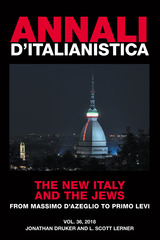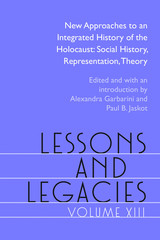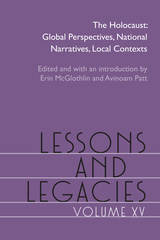3 books about Druker, Jonathan

Annali d'Italianistica
The New Italy and the Jews from Massimo d'Azeglio to Primo Levi
druker
Arizona Center for Medieval and Renaissance Studies, 2018
Founded in 1983, Annali d’italianistica has become synonymous with timely and fundamental scholarship on Italy’s literary culture, employing broad historical, cultural, and literary perspectives that are of interest to a wide variety of scholars. Published annually and monographic in nature, the journal uses as its point of departure the study of Italian literature and the Humanities more generally to foster scholarly excellence at all levels. Annali d’italianistica is receptive to a variety of topics, critical approaches, and theoretical perspectives that cross disciplinary boundaries and span several centuries, from the beginning of Italy’s cultural history to the present.
[more]

Lessons and Legacies XIII
New Approaches to an Integrated History of the Holocaust: Social History, Representation, Theory
Edited and with an introduction by Alexandra Garbarini and Paul B. Jaskot
Northwestern University Press, 2018
Lessons and Legacies XIII: New Approaches to an Integrated History of the Holocaust is an edited collection of thirteen original essays that reflect current research on the Holocaust in a range of disciplines.
[more]

Lessons and Legacies XV
The Holocaust; Global Perspectives, National Narratives, Local Contexts
Erin McGlothlin; Aviroam Patt
Northwestern University Press, 2024
The fifteenth volume in the Lessons & Legacies series, featuring multidisciplinary research in the Holocaust and Jewish cultural history on the theme of Global Perspectives and National Narratives. The fourteen chapters included in this volume manifest three broad categories: history, literature, and memory. These chapters continue the recent trend in Holocaust Studies of a focus on local history, integrating specific regional and national narratives into a more global approach to the event. Newer studies have continued to incorporate what was once termed the periphery into a more global examination of the experiences of Jewish refugees in flight to Latin America, Africa, and the Soviet Union. At the same time, very specific local studies deepen our knowledge of the mechanics of genocide, along with the experiences of refugees in flight, and the subsequent dimensions of Holocaust memory and representation.
New research on Holocaust literature continues to unearth unexamined texts from the period of the war itself, which can shed light on Jewish responses to persecution and strategies for survival. The study of Holocaust testimonies continues to grapple with the challenge of language: how to convey through the limits of human language the depths of barbarity to an audience that could never fully understand what they had not personally experienced. Likewise, literary studies continue to incorporate texts that were once considered outside the standard canon of Holocaust literature, such as science fiction and children’s literature.
The tension between local and global perspectives can also be seen quite clearly in what the volume's editors understand by the term “memory studies,” or new approaches to research on museums and memorials. The very specific nature of collective memory on the national level continues to be the site of the contested “politics of memory.” A number of the chapters in this volume engage with the conflict of monuments and memorials, museums’ attempts to resolve provenance issues, questions around the ethics of Holocaust tourism, and the inclusion of new technologies and digital survivors into the memorial landscape.
New research on Holocaust literature continues to unearth unexamined texts from the period of the war itself, which can shed light on Jewish responses to persecution and strategies for survival. The study of Holocaust testimonies continues to grapple with the challenge of language: how to convey through the limits of human language the depths of barbarity to an audience that could never fully understand what they had not personally experienced. Likewise, literary studies continue to incorporate texts that were once considered outside the standard canon of Holocaust literature, such as science fiction and children’s literature.
The tension between local and global perspectives can also be seen quite clearly in what the volume's editors understand by the term “memory studies,” or new approaches to research on museums and memorials. The very specific nature of collective memory on the national level continues to be the site of the contested “politics of memory.” A number of the chapters in this volume engage with the conflict of monuments and memorials, museums’ attempts to resolve provenance issues, questions around the ethics of Holocaust tourism, and the inclusion of new technologies and digital survivors into the memorial landscape.
[more]
READERS
Browse our collection.
PUBLISHERS
See BiblioVault's publisher services.
STUDENT SERVICES
Files for college accessibility offices.
UChicago Accessibility Resources
home | accessibility | search | about | contact us
BiblioVault ® 2001 - 2024
The University of Chicago Press









